- Products
-
-
Product Features
-
Explore More
-
-
- Solutions
-
-
By Industry
By Department
-
By Business Need
-
-
- Learn & Support
-
-
Product Education
-
Product Support
-
-
- Resources
-
-
Insights
Events
-
-
- Partners
-
SITUATION
• Responsible for clients’ sensitive legal documentations
• Office needed a secure single source of truth that could automate and standardize processes while addressing regulatory requirements
RESULTS
• 450% increase in some business segments
• Client orders processed without having to increase staff at the same scale
• Creation of living trusts reduced from six hours to 15 minutes

Notaría 9 de Mexicali B.C. is a Mexicali-based notarial service under the leadership of public notary Carlos Enriquez de Rivera Castellanos. The office, one of Mexico’s leading legal notaries, provides a wide range of services including real estate transactions, will and estate planning, contract affirmations, new business incorporation, and legal document authentication. Public notaries in Mexico follow a civil law system wherein they are given further-reaching legal responsibilities than their counterparts in the U.S., U.K. or Canada, more akin to a lawyer.
This legal responsibility includes complex regulatory considerations when handling client information. Notary servicers in Mexico are required to submit client information to city clerks, in addition to retaining it for a minimum of five years. Additionally, notary offices are regularly audited by an independent commission, which cross matches stored records with those that are submitted to city clerks.
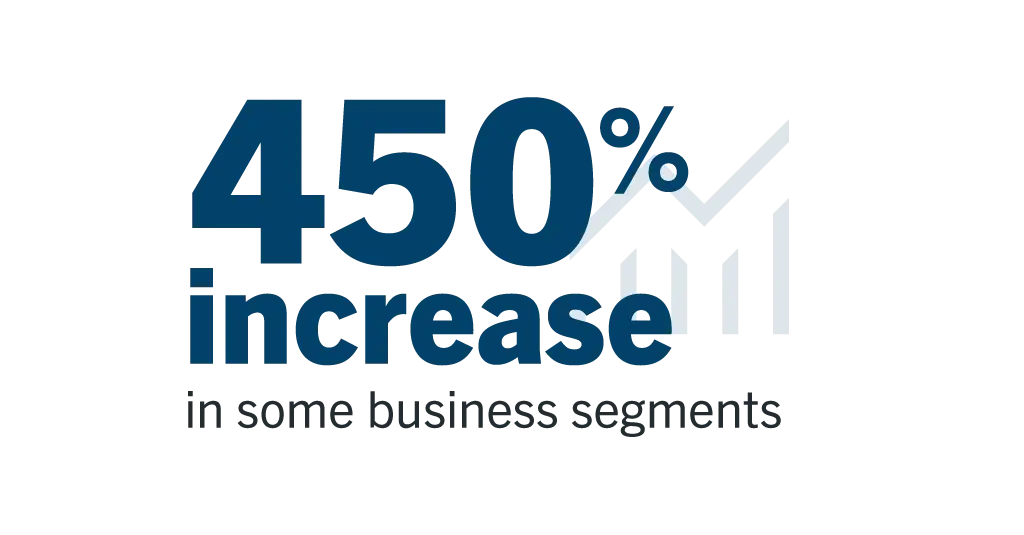 As Notaría 9 grew, so did the need to efficiently handle large volumes of client documentation in accordance with regulatory requirements. This led Enriquez de Rivera Castellanos to work with digital solutions provider Soluciones Impex, SA de CV, to implement Laserfiche. Since embarking on this digital transformation journey, the firm has more than quadrupled its business while only doubling its staff.
As Notaría 9 grew, so did the need to efficiently handle large volumes of client documentation in accordance with regulatory requirements. This led Enriquez de Rivera Castellanos to work with digital solutions provider Soluciones Impex, SA de CV, to implement Laserfiche. Since embarking on this digital transformation journey, the firm has more than quadrupled its business while only doubling its staff.
“Carlos has driven a vision for digital transformation at his business and has managed to consolidate all the necessary pieces to make operations more reliable and efficient,” said Guillermo Hernandez, managing director and founder of Soluciones Impex. “Using technology as the main enabler, Carlos has made Notaría 9 into the most advanced notary public in Mexico.”
“Laserfiche has put us ahead of everyone else in this business. I have all of the tools and resources I need thanks to Laserfiche”
— Carlos Enriquez de Rivera Castellanos, Notary Public, Notaría 9 de Mexicali B.C.
“If I didn’t have Laserfiche I wouldn’t be in the same position right now with the benefits I’m able to give to my clients,” said Enriquez de Rivera Castellanos. “We cannot work without Laserfiche.”
Prior to Laserfiche, the office was overwhelmed with managing documentation in a mostly manual fashion. More clients led to an increase in documents as well as increased risk of lost information. The office needed a digital solution that would keep documentation in a consolidated platform that would provide the security and searchability it needed to efficiently serve clients.
Laserfiche addressed those needs, enabling the firm to keep documents for every transaction in a single platform and facilitating the easy retrieval of information. As an added bonus, the office in charge of the public registry in Baja California also uses Laserfiche, making for a seamless transfer of information between the organizations.
“In the beginning, we focused on two main activities: one, to keep all documents for every single transaction inside Laserfiche, and two, to understand in which phase of a transaction that a customer was currently located,” Enriquez de Rivera Castellanos said.
With Laserfiche process automation, the office began to standardize processes, which provided a better understanding of how long each process takes, and where there was opportunity to optimize.
As Notaría 9 evolved, Rivera Castellanos continued to evolve the office’s use of the Laserfiche platform. One of the most forward-thinking Laserfiche solutions Notaría 9 leverages today is its Living Trust process.
In 2022, Mexico reformed the “Reforma a la Ley de Proteccion al Patrimonio Familiar,” a law that encourages families to create a living trust to protect their real estate assets. As a part of this reform, September was deemed “Living Trust Month” and the government mandated that many services related to preparing living trusts be discounted.
“We never used to do a lot of living trusts for our clients over the course of any given year,” Enriquez de Rivera Castellanos said. “Now, everyone waits until September to take advantage of the discount, so we have a full office during this time.”
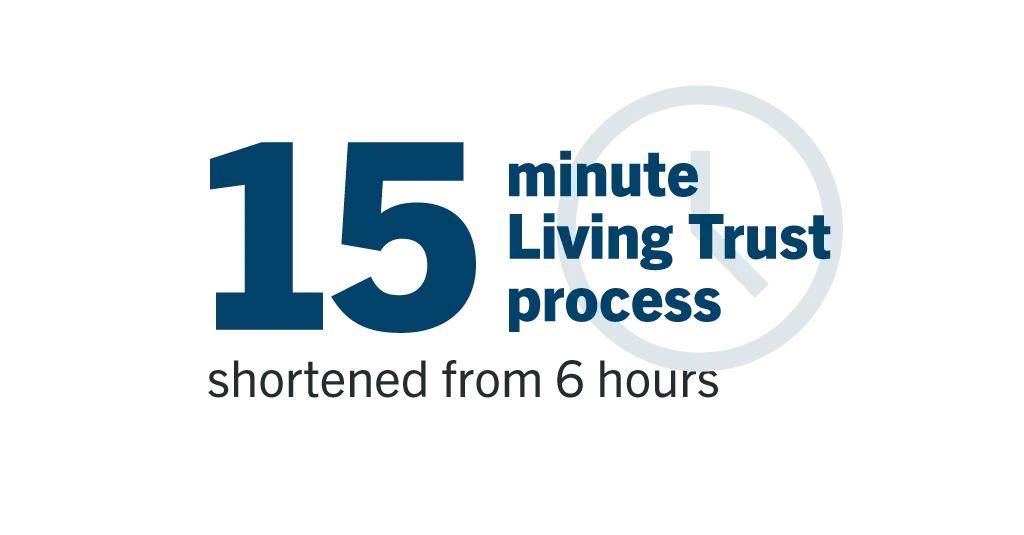 The Notaría 9 team saw an opportunity to leverage Laserfiche to digitize and automate the living trust creation process. Rather than require clients to submit paper forms, clients are provided a link to a Laserfiche form where they enter their information and attach required documents. Clients can also pay online — from there, a Notaría 9 employee will make an appointment with the client to provide a wet signature as required by the Mexican government. The new process enabled the firm to reduce the Living Trust process from a six-hour in-person visit to a hybrid 15-minute process.
The Notaría 9 team saw an opportunity to leverage Laserfiche to digitize and automate the living trust creation process. Rather than require clients to submit paper forms, clients are provided a link to a Laserfiche form where they enter their information and attach required documents. Clients can also pay online — from there, a Notaría 9 employee will make an appointment with the client to provide a wet signature as required by the Mexican government. The new process enabled the firm to reduce the Living Trust process from a six-hour in-person visit to a hybrid 15-minute process.
Today, Notaría 9 manages this spike in activity due to the government mandated discounts with ease, while preemptively avoiding the additional overhead each year.
“It’s also easier for the people in my office because they have all the information already completed, and they can just verify it and make the appointment,” Enriquez de Rivera Castellanos added.
The innovative Laserfiche solution has built Notaría 9’s reputation as a digital innovator in the industry, while also building trust with clients government agencies.
As a legal business, Notaría 9 must be conscious of complex regulatory requirements. Anti-Money Laundering (AML) laws require robust recordkeeping and document-sharing framework between notaries and their regulatory agency.
Additionally, when client service is related to buying or selling property, Notaría 9 is required to process documents multiple times through Infonavit, or Mexico’s National Housing Fund Institute. Using Laserfiche’s intelligent capture and processing capabilities, the firm has set up a process that automatically routes the information to Infonavit without human intervention.
Beyond government regulators, independent auditors are another consideration for the office. When the Notaries General performs an audit, it requires that the documentation the office sends to the city clerk is identical to the documentation stored within the organization. Laserfiche assists with these regulatory needs through:
Notaría 9’s visionary Laserfiche solutions have enabled significant business growth, allowing the firm to provide an exceptional client experience, while building trust with regulatory agencies. As the firm continues to optimize operations, the Living Trust process serves as a template for other services such as New Business Incorporation, Power of Attorney, and other legal processes.
“Laserfiche has put us ahead of everyone else in this business. I have all of the tools and resources I need thanks to Laserfiche.”
— Enriquez de Rivera Castellanos, Notaría 9
SITUATION
• Mackenzie District Council needed an ECM system to support efficient service delivery
• Data security and recordkeeping requirements were top priorities
RESULTS
• Expanded use of Laserfiche from an electronic filing cabinet to a source of truth and workflow orchestration engine
• Integrations with core technologies such as the district council’s ERP enable automated solutions and increased efficiency
• Additional integrations and automated solutions will continue to enhance the employee and customer experience
Mackenzie District Council is one of New Zealand’s 53 district councils, responsible for providing services and managing issues ranging from local infrastructure and building consents to emergency services and food safety. With this broad range of duties, the district council relies on a core group of systems to enable its staff to deliver services efficiently, while keeping data secure and addressing recordkeeping requirements.

“We’ve got a handful of core systems that sit at the heart of our ecosystem,” said Chris Clarke, general manager of Information, Engagement and Community at Mackenize District Council. “One of those is our ERP and of course there’s Office 365, and I would put Laserfiche right up there with those systems. We deal with a lot of confidential information and we have complex recordkeeping requirements, and now it is becoming our workflow orchestration engine. It’s one of the essential tools that all of us use on a daily basis and could not function without.”
When Clarke assumed oversight of the district council’s IT department, the organization performed an assessment of its existing tech stack, revealing significant opportunity for improvement. “Internally, at the time, Laserfiche was perceived as an electronic filing cabinet,” Clarke explained. “But we realized that there was untapped potential for process automation and automated workflows.”
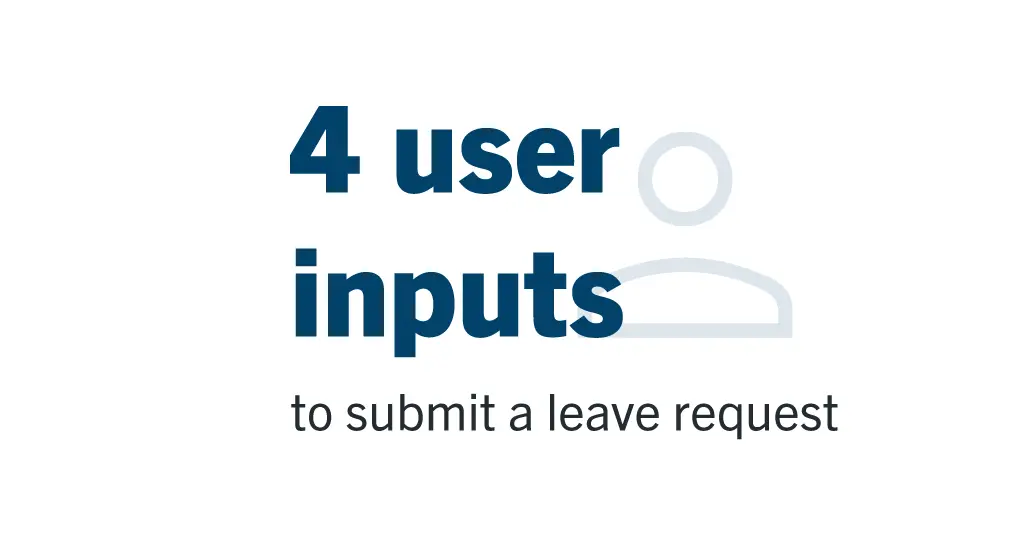 The team got to work on establishing Laserfiche as the district council’s source of truth for recordkeeping, and integrating it with the ERP for a critical solution that the entire organization used: time off requests. “Holiday and leave forms were the first thing we automated because everyone takes leave, and lots of people in the organization have to process leave,” Clarke said. This deceptively small project made a big impact, transforming what once required downloading paper forms, signing them and attaching them to emails for processing, into a task that now took mere seconds.
The team got to work on establishing Laserfiche as the district council’s source of truth for recordkeeping, and integrating it with the ERP for a critical solution that the entire organization used: time off requests. “Holiday and leave forms were the first thing we automated because everyone takes leave, and lots of people in the organization have to process leave,” Clarke said. This deceptively small project made a big impact, transforming what once required downloading paper forms, signing them and attaching them to emails for processing, into a task that now took mere seconds.
“When we first rolled it out, people were skeptical of whether it actually worked, because it seemed too easy,” Clarke added. “All they had to do was two clicks, and they couldn’t believe that was the case.”
IT has now set its sights on transforming the rest of the organization’s workflows, taking a thoughtful approach to change management and prioritization.
“What we’re trying to do is change the perception that Laserfiche is another piece of business software that you just need to use because of recordkeeping requirements,” Clarke said. “It’s about winning hearts and minds, and getting things done. People are starting to think about Laserfiche now as a tool that helps with work, as opposed to yet another system to be wrestled with.”
Clarke and his team have set their sights on systematically transforming the way the district council manages its records, with the goal of leveraging Laserfiche to automate the records management lifecycle, including retention schedules and disposition.
“We’re doing a taxonomy review to assess our existing recordkeeping, and working through licensing, security, roles, etc.,” said Zane Woodfield, ICT manager at Mackenzie District Council. “One of the things that I like about Laserfiche is that we are creating a technology demarcation point-slash-security boundary from all other stuff that’s in the cloud. Now that we have set up Microsoft Entra SSO authentication and some of the foundational pieces with Laserfiche, we feel secure and safe enough to do more.”
Laserfiche’s robust security and compliance tools also support the Mackenzie IT team’s mission to innovate while addressing data safeguards and critical recordkeeping needs.
“For us to impact the organization’s records and processes, we have to have confidence that the audit trail is there; we have to have confidence that the information is going to go to the right people. We have to have all of that confidence in place — and we do with Laserfiche.”
— Chris Clarke, IT General Manager, Mackenzie District Council
“Having the right local support in place has also been a critical part of our success,” added Clarke. “Laserfiche is a very capable and flexible product, but that can bring with it some complexity to ensure the system is configured to meet our specific business needs. Our local partner, ifTHEN, has taken the time to understand our business and our process requirements, and as a result has been able to assist us to configure Laserfiche in a way that delivers the optimum solution to our needs. Without their experience and insight, we would not have been able to effectively utilise many of the more advanced features which are now adding value to both our staff and customers on a daily basis.”
Mackenzie District Council’s IT department has laid a strong foundation for transformative change, and team members are excited to realize the potential for Laserfiche across the organization. Along with their Laserfiche solution provider, ifTHEN Limited, the team feels confident that their Laserfiche initiatives will be a gamechanger for all departments and those they serve.
“We’re just about to embark on a project where we go out to the business and get everyone’s wish list,” Clarke said. “We know that list will be large, but we are hyper focused on the things that really make a difference and give us the biggest bang for our investment, as we’re dealing with public funds.”
One significant project on the horizon is implementing a public portal to make it easier for the public to interface with the district council. Currently, the council’s website hosts downloadable forms that must be scanned or reuploaded for processing, but the IT team hopes to replace those “dumb forms” with Laserfiche Forms. “We’re working through public iterations of forms that will truly transform the customer experience,” Clarke said. “We’re really excited about that.”
 Additional integrations on the roadmap will bring even more possibilities for automated solutions, including an integration with the district council’s GIS and building consent management systems to help streamline the building consent process. As the district council and IT continue to uncover new efficiencies with their Laserfiche projects, the future looks bright.
Additional integrations on the roadmap will bring even more possibilities for automated solutions, including an integration with the district council’s GIS and building consent management systems to help streamline the building consent process. As the district council and IT continue to uncover new efficiencies with their Laserfiche projects, the future looks bright.
“We’ve done the foundational work, so we feel we’re at the beginning of our journey in terms of leveraging the benefits,” Clarke said. “Who knows where it will take us? One of the things that I see which is encouraging is that Laserfiche continues to evolve. We don’t know what the future holds, but I’m confident that Laserfiche will be on that journey with us.”
SITUATION
• Needed to replace a legacy enterprise content management (ECM) system
• Sought a more robust, easier to use platform with advanced integration and automation capabilities
RESULTS
• Common forms and workflow platform shared across schools, sites and departments
• Standardized and automated key processes, including Position Control, the Head Injury Protocol, Student Cumulative Folders and Choice Program applications
• Boosted efficiency and enhanced responsiveness
• Able to better allocate personnel and budget to focus on student outcomes
Palo Alto Unified School District (PAUSD) has been recognized as the No. 1 ranked school district in America with over 10,000 students. These high standards extend throughout all of the district’s operations, from enrollment and academics to hiring and IT processes.
“We’re in the heart of Silicon Valley, and with that comes some high expectations,” said Derek Moore, chief technology officer (CTO) at PAUSD. “With the improvements that we’ve made in our technology and processes, we’ve also raised the bar for ourselves.”

This constant evolution led the district to assess legacy systems and processes, to ensure the highest level of efficiency in operations, with the lowest amount of friction to users. Key to the district’s continuous improvement has been Laserfiche, with which PAUSD replaced a legacy enterprise content management (ECM) system. Laserfiche’s ease of use, adaptability to the district’s Mac OS environment, and advanced integration and automation capabilities were the major differentiators that drove PAUSD’s decision.
Today, with support from PAUSD’s Laserfiche solution provider ECS Imaging, Laserfiche has become a core component of the district’s tech stack, helping to integrate and orchestrate data and processes across the organization and support the district’s mission to keep the focus on students and student outcomes.
“Laserfiche is our Swiss Army knife,” said Moore. “If one of our business systems doesn’t have a solution that meets one of our needs, we fill that gap with an integration with Laserfiche. Whether we need to do a form to augment some other process or figure out how to input data — Laserfiche is our answer.”
Since implementing Laserfiche, PAUSD has integrated it with core pieces of the district’s technology infrastructure to enable more seamless process and information flow. Key integrations include Infinite Campus, the district’s student information system (SIS), as well as ERP, active directory, and single sign-on integrations.
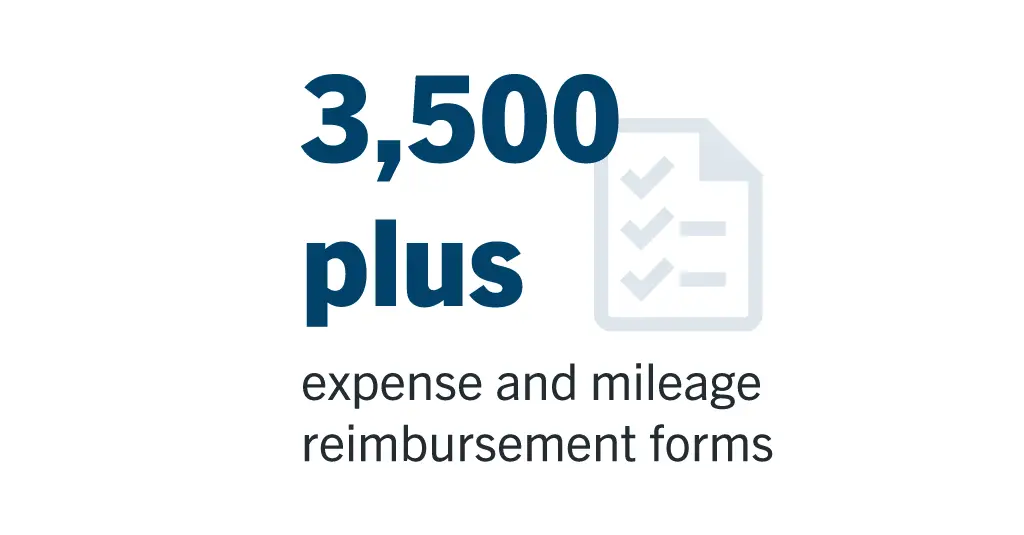 “Laserfiche is the automation engine behind a lot of the tools or applications that we’re using which don’t have a good user interface to do the things we need to do,” said Joshua Hung, business systems analyst at PAUSD.
“Laserfiche is the automation engine behind a lot of the tools or applications that we’re using which don’t have a good user interface to do the things we need to do,” said Joshua Hung, business systems analyst at PAUSD.
In addition to connecting formerly disparate sources of information and enabling automation of key workflows, Laserfiche has helped to create a culture of continuous improvement and process automation at the district.
“Laserfiche has facilitated better communication between departments and between people,” Moore said. Mapping out processes to validate or question each step has strengthened teams’ understanding of how or why actions are taken. “It’s really helped define our organizational processes in a way that I don’t think anyone in the organization understood. We’ve got a whole list of departments and processes that touch Laserfiche, from our student services to human resources, to our business office and our educational services. Laserfiche has been the backbone.”
One critical process that helped to get teams excited about Laserfiche-driven improvements was the Head Injury Protocol. Because head injuries — from minor bumps to serious blows — can have serious health implications, the process of reporting them requires significant documentation and multiple notifications to be distributed internally and externally.
Transforming the legacy, paper-driven process with a Laserfiche solution meant that documenting these events were now a lot less manual and less time-intensive, but also reported with more accuracy and accountability.
Because of the integration between Laserfiche and Infinite Campus, a staff member can now enter a student number into the Laserfiche form and the necessary information populates the form — parents’ contact information, parents’ email addresses, etc. From there, the staff member simply answers the required questions and submits the form. The principal then approves it, and the information is distributed to the nurse’s office, risk management, legal services, and the child’s parents.
Transformation of the Head Injury Protocol inspired various teams to realize the power of Laserfiche solutions. “It’s a really fun place to be,” Moore said. “Our users are bringing ideas to us, and we’re able to evaluate and prioritize projects. We’re thinking about our pain points as an organization and how we can create Laserfiche Forms processes to solve them.”
Building on the initial success, PAUSD began creating more standardization around other processes that require the alignment of multiple departments, approvals and systems.
“Our entire organization’s staff is very competent and wants to be empowered to do the job themselves,” Moore said. “That’s where Laserfiche fits in. We help by building small pieces for them or helping to standardize a process. Laserfiche empowers them to complete the tasks that they’re charged with without requiring a lot of tech team intervention.”
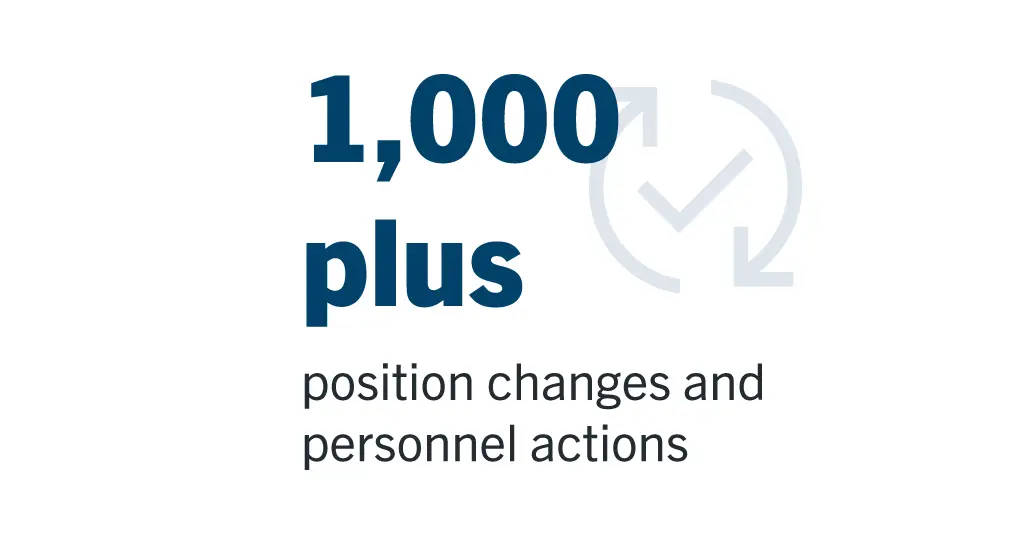 A complex yet critical process at the school district, Position Control is one such process which enables the district to track hiring and monitor costs related to various positions. Previously a paper form that was physically passed from stakeholder to stakeholder, the process is now digital and automatically routed in Laserfiche, leveraging an integration with the district’s ERP system. “The Laserfiche process ensures that we are fulfilling the necessary roles from an HR hiring perspective, to the business fiscal department, making sure there’s budget allocated for it,” Moore added.
A complex yet critical process at the school district, Position Control is one such process which enables the district to track hiring and monitor costs related to various positions. Previously a paper form that was physically passed from stakeholder to stakeholder, the process is now digital and automatically routed in Laserfiche, leveraging an integration with the district’s ERP system. “The Laserfiche process ensures that we are fulfilling the necessary roles from an HR hiring perspective, to the business fiscal department, making sure there’s budget allocated for it,” Moore added.
The updated, expedited process extends to the IT team, which is now automatically notified when people are hired so that accounts and access can be set up immediately. “We want to make the new employee feel welcome,” Moore explained. “We’re onboarding them with a good experience and making sure they have everything they need so they’re ready to go on day one.”
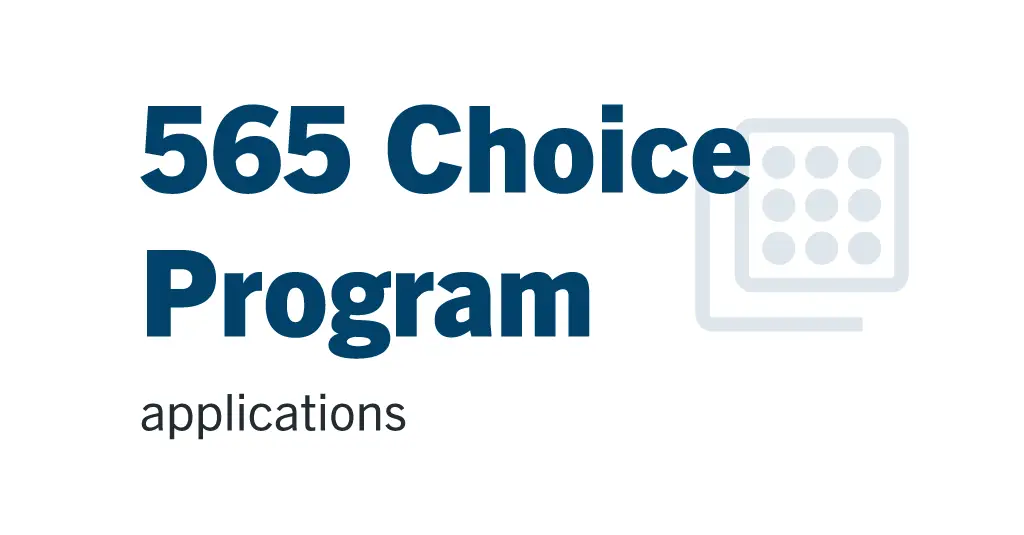 As PAUSD builds a more automated future, Moore and his team understand the importance of being digital-first. One large step the district took toward this goal was to digitize all student cumulative folders, which contain students’ permanent records, including personal information, enrollment, academic records, and other relevant information. The IT team built a Laserfiche form and workflow to input, tag and sort all student documents into the correct places.
As PAUSD builds a more automated future, Moore and his team understand the importance of being digital-first. One large step the district took toward this goal was to digitize all student cumulative folders, which contain students’ permanent records, including personal information, enrollment, academic records, and other relevant information. The IT team built a Laserfiche form and workflow to input, tag and sort all student documents into the correct places.
“We can say at this point that all of our active files are electronic,” Moore said. “Some information comes in as paper if it starts in another district, for instance, or it may be a doctor’s note that needs to be scanned in. But it’s scanned in via a Laserfiche form.”
This digital-first approach is also evident in the processes that collect information externally, as in PAUSD’s Choice Programs process. PAUSD Choice Programs offer parents and students options beyond their assigned neighborhood school, providing diverse learning environments for different interests and needs.
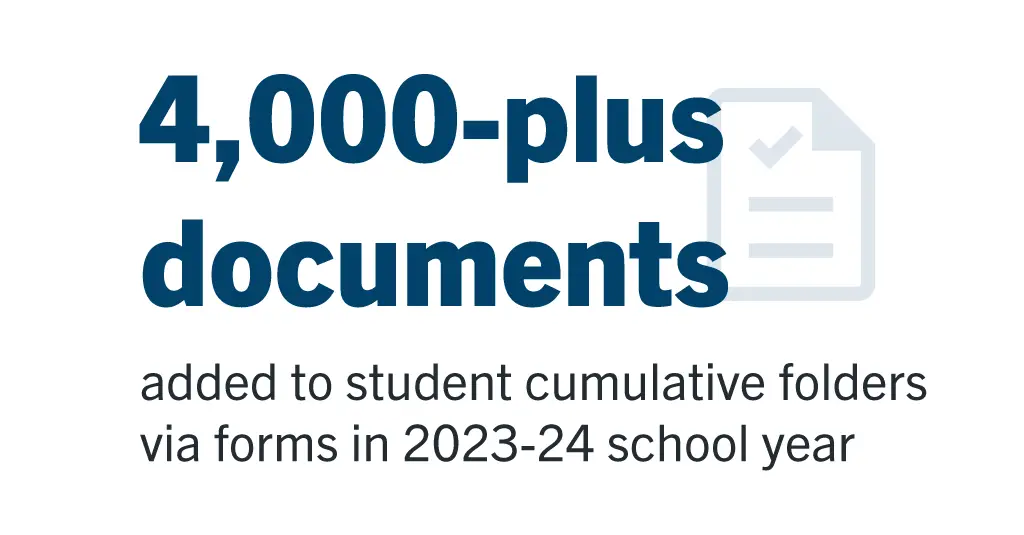
The district enables parents to fill out a public Laserfiche form, which is routed to staff members who validate the information through an integration with the SIS. The workflow also pulls additional data into the form that needs to be evaluated.
“These lookups save reviewers a lot of time, because instead of clicking to five different pages where the information exists, it’s all there on that one page,” said Hung. Additionally, the Laserfiche form enables the district to collect accurate data from the outset, eliminating the time-consuming data cleaning that used to be inevitable in the legacy process. “We also created a notification process with Laserfiche, to make sure that parents and students receive the right notifications for the specific lottery programs they are being accepted to. Our staff can just click a button that sends out notifications as part of the business process; it’s made it a lot less stressful.”
The IT team continues to innovate the organization’s many processes and procedures that make up PAUSD’s operations. One of the best parts of using Laserfiche for this innovation, the team says, is that they know they are not alone.
“We go to the community events to connect with other Laserfiche users, and we communicate about what challenges they’ve run into, or what new processes they are trying,” Hung added. “We learn from them, and we can pass on what we’re doing, too.”
As the district grows, the technology team is confident in its ability to support the student-centric mission of the organization. Through digital solutions, PAUSD can prioritize the programs and budget items that are going to have a positive impact on student outcomes.
 “We’re still adding people and adding positions, but what we’re not talking about adding is people to simply process paperwork or process data,” said Moore. “We’re more focused on how we can better use people and budget to serve students.”
“We’re still adding people and adding positions, but what we’re not talking about adding is people to simply process paperwork or process data,” said Moore. “We’re more focused on how we can better use people and budget to serve students.”
Persistent labor shortages are a pressing challenge for today’s manufacturers. The industry’s current skills gap is predicted to balloon to 2.1 million unfilled jobs by 2030, which will cost employers an estimated $1 trillion per year. This makes adding automation to increase efficiencies and optimize throughput a top priority across the industry. Smart manufacturing technologies, ranging from digital twins and robots to the use of data analytics to streamline production processes, promise to ease the difficulties associated with the current labor shortage. But automating factory floor operations isn’t simple. It requires massive investments in equipment, data infrastructure and employee training.
Manufacturers may be eager to embrace smart technology innovations, but leaders in smaller firms may struggle to understand where to begin. Meanwhile, larger enterprises are often inhibited by organizational silos or a need to prove short-term return on investment (ROI) when end results may be months, if not years, in the future. Implementing the right data strategy and enterprise architecture can make it possible to overcome these obstacles.
Many manufacturing firms — especially those with complex compliance requirements — create and process large volumes of documents to support their operations. To avoid redundancies and inefficiencies, they need to leverage automation to create a single source of truth and align workflows across the entire organization. This sets the foundation for digital transformation. The right data management strategy successfully melds data across diverse business processes — from sales and inventory management through logistics and quality assurance — into a unified informational backbone. With this data strategy in place, manufacturers will be prepared for success in smart manufacturing.
The National Institute of Standards and Technologies (NIST) defines smart manufacturing as a set of fully integrated, collaborative systems that respond in real time to meet changing demands and conditions in the factory, in the supply network and from customers. Realizing this vision requires harnessing digital technologies to realize greater efficiencies than are possible in traditional production processes. Machines and operators should be sharing information about performance, efficiency and maintenance needs on an ongoing basis to maximize agility and minimize unplanned downtime.
Becoming “smart” means embedding sensors in production equipment to gather data about operational status and performance. But it also requires an infrastructure for sharing, processing and analyzing that data. Taking advantage of the cloud’s near-infinite scalability makes it possible to manage the enormous volumes of data involved.
A mature smart manufacturing ecosystem involves much more data than what’s output by operational technology (OT) systems and sensors, though. It should also incorporate product designs, sales information, logistics tracking (for both finished products and materials), financial results and more. Thinking holistically about all of this data is the secret to successfully advancing your organization’s smart manufacturing maturity.
This playbook will give a three-step roadmap to ready your organization for smart manufacturing. Standardizing document and data management paves the way for digitizing business processes across the organization. This will ultimately allow you to glean value from the smart systems on your factory floor faster and more easily.
Want to learn more? Download the full ebook: 3 Steps to Ready Your Business for Smart Manufacturing.